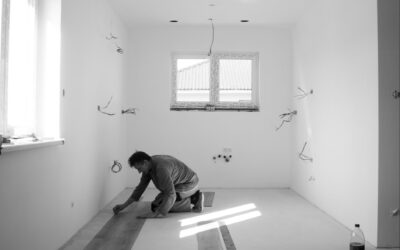LVT flooring isn’t a universal one-size-fits-all product and there are hundreds of brands, colors, styles, and qualities. Another area where LVT flooring varies is the thickness and this is something that you should consider before buying new flooring.
In simple terms, LVT flooring thickness can be anywhere from 2mm to 6.5mm but it is more complicated than that as you have to consider individual components like the wear layer. To enlighten you, I answer the question of, how thick is LVT flooring below in detail, including the impact thickness has on longevity and performance.
Understanding LVT Flooring Thickness
As stated, you can get LVT flooring in a thickness of between 2mm to 6.5mm and this denotes the overall thickness or gauge which I discuss below. Within that, there is also the wear layer which plays an important role in resistance to wear and tear for things like click LVT and glue-down LVT.
Wear Layer Thickness
The wear layer is the top, transparent layer made from virgin or recycled PVC. This is a protective layer that stops the aesthetic and core vinyl layers from getting damaged. It is resistant and can withstand a decent amount of punishment although it can be scratched.
There are different wear layer thicknesses and the simple principle is that the thicker the wear layer, the more resistant to wear and tear it is. Wear layer thicknesses range from 0.2mm to 1mm with 0.3mm, 0.55mm, and 0.7mm being the most common options.
Gauge or Overall Thickness
The wear layer is included within the overall thickness of LVT flooring and this is known as the gauge. LVT gauge denotes the overall thickness and this can range from 2mm to 6.5mm. 5mm is generally the most common overall thickness and this provides excellent durability and resistance to wear and tear depending on the wear layer.
Typically, you get specific wear layer thickness with certain gauges for example, a wear layer of 0.5mm is commonly paired with an overall gauge of 4mm.
How Thickness Affects LVT Flooring Utility
As you can see, how thick is LVT flooring isn’t a simple question and there is a wide range of thicknesses of both the overall gauge and the wear layer. It’s important to put this into a context too, and understand what this actually means for the durability, suitability, and longevity of your LVT flooring.
A Thicker Wear Layer is More Durable
When looking at how thick is LVT flooring, the most important consideration is the wear layer thickness. Simply put, a thicker wear layer means greater durability and resistance to damage.
The difference might seem small between a 0.2mm wear layer and a 0.55mm layer, but comparatively, that is more than a 50% increase in thickness so the difference is actually pretty great.
A thicker wear layer is better suited for areas of high traffic or if you have children or pets. The thicker layer will be more resilient to any spills and drops and protect better against the pitter-patter of animal claws.
A Thicker Gauge Means Greater Longevity
A thicker gauge also generally results in better longevity. In most instances, LVT flooring can last between 25-30 years but this can differ depending on the thickness of the gauge, and the wear layer. I have bulleted some examples of thickness and longevity below:
- 2mm gauge: 10 years.
- 3mm gauge: 20 years (25 with a thicker wear layer).
- 5mm gauge: 20 years (25-30 years with a thicker wear layer).
The difference in thickness is real and as you can see it has an impact on the longevity and ultimately your investment and the cost-effectiveness of your LVT flooring. By spending a little more on a thicker LVT flooring you can save overall due to the increased longevity.
Thicker LVT is Better for High-Traffic Areas
Lastly, it’s a no-brainer, but thicker LVT (either gauge or wear layer or both) is the best option for high-traffic areas such as hallways, kitchens, and living rooms.
The increased thickness and wear layer simply means that all that foot traffic and trampling doesn’t degrade the quality as quickly or cause noticeable damage. You can also consider something like rigid core LVT that has an enhanced thicker core vinyl layer for even more durability.
Consider the Usage and Purpose When Evaluating LVT Flooring Thickness
We can generally say that thicker LVT is more durable and has a longer lifespan. However, that doesn’t always mean it’s the better choice as the thicker the LVT, the more expensive it becomes.
If you want this type of flooring in a low-traffic area such as a conservatory or bedroom (compared to a hallway or living room), is it really necessary to opt for a thicker LVT flooring type? Instead, in this instance you could opt for a thinner make and save money and still get similar longevity.









